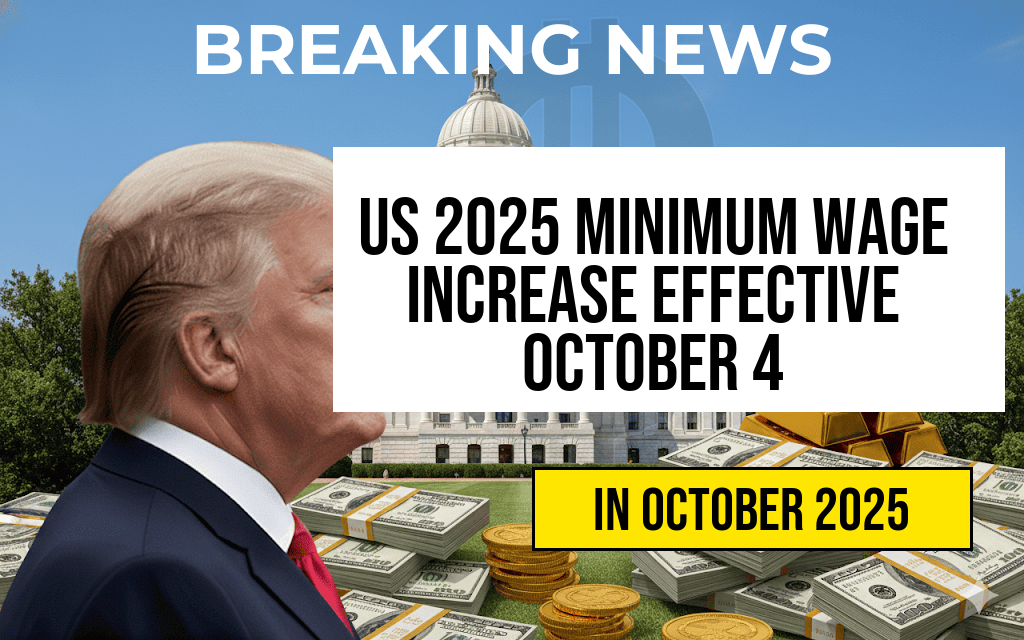Effective October 4, 2024, the United States will see an official increase in the federal minimum wage for 2025, marking a significant step in the ongoing debate over fair pay and economic policy. The new hourly rates are set to impact millions of workers across various industries, with some states and cities already implementing their own adjustments that align with or exceed the federal baseline. This update reflects a broader effort to address cost-of-living increases and income inequality, although debates persist regarding the potential effects on employment and small businesses. The federal minimum wage, which has remained $7.25 since 2009, will see a notable rise, with many regions supplementing the federal baseline through local legislation. This article explores the specifics of the upcoming wage changes, the factors influencing these adjustments, and the broader economic implications for workers and employers alike.
Details of the 2025 Minimum Wage Increase
Federal Rate Adjustment
The Department of Labor announced that starting October 4, 2024, the federal minimum wage for 2025 will increase to $8.50 per hour. This marks a significant change from the long-standing rate of $7.25, which has been in place since 2009. The increase is part of an automatic adjustment mechanism tied to inflation, as mandated by the Fair Labor Standards Act (FLSA), designed to ensure wages keep pace with rising living costs.
State and Local Variations
While the federal baseline is set at $8.50, several states and local jurisdictions have already established higher minimum wages. For example:
- California is scheduled to increase its minimum wage to $15.50 per hour for large employers, with smaller businesses following suit gradually.
- New York will see a statewide minimum of $13.50 for large employers, with some areas like New York City and Westchester County setting their own higher rates.
- Washington will adjust its minimum wage to $15.74 per hour, reflecting its commitment to a higher baseline.
These regional variations demonstrate the patchwork approach to wage standards across the country, often driven by local economic conditions and political priorities.
Impacts on Employers and Workers
Employers are preparing for increased labor costs, particularly in sectors heavily reliant on minimum wage workers such as retail, hospitality, and food service. Many business owners express concerns over potential reductions in staffing levels or increased prices to offset higher wages. Conversely, workers anticipate improved purchasing power and reduced economic hardship, especially in areas with a high cost of living.
Economic Context and Policy Considerations
Inflation and Cost of Living
The wage increase aligns with ongoing efforts to mitigate the effects of inflation, which has eroded real income for many Americans over the past decade. According to economic analyses, modest wage hikes can help stabilize consumer spending, a key driver of economic growth. However, critics warn that rapid increases could lead to inflationary pressures or employment reductions, particularly for low-skilled workers.
Political and Social Debate
The minimum wage debate continues to polarize policymakers. Advocates argue that a higher baseline is essential for reducing income inequality and supporting economic mobility. Opponents contend that mandated increases could burden small businesses and lead to job losses, especially in regions where labor markets are already fragile. The Biden administration emphasizes that incremental adjustments are necessary to balance economic stability with social equity.
Projected Economic Effects and Future Outlook
| Jurisdiction | Effective Date | Minimum Wage |
|---|---|---|
| Federal | October 4, 2024 | $8.50 |
| California | January 1, 2025 | $15.50 |
| New York | December 31, 2024 | $13.50 |
| Washington | January 1, 2025 | $15.74 |
Analysts suggest that the wage hike may contribute to increased consumer spending but could also prompt some employers to automate or reduce their workforce. The overall effect will depend on regional economic conditions and how policymakers, businesses, and workers adapt to these changes. The Department of Labor continues to monitor economic indicators to inform future adjustments to minimum wage policies.
For additional insights into the history of minimum wage laws, visit Wikipedia’s Minimum Wage Law page. To explore economic analyses and policy debates, Forbes offers in-depth coverage at Forbes.com.
Frequently Asked Questions
What is the new minimum wage rate effective October 4, 2025?
The U.S. minimum wage has increased to an updated hourly pay rate effective October 4, 2025. The specific rate varies by state and locality, but all are adjusted to reflect the new federal or regional standards.
Which states or cities have the highest minimum wage increases?
Some states and cities are implementing higher minimum wages based on local legislation. Notably, jurisdictions like California, Washington, and New York have announced significant increases to support workers.
Who is eligible for the increased minimum wage?
The updated minimum wage applies to hourly employees working within covered jurisdictions. Certain exemptions or special rules may apply depending on the industry or employment type.
How does the 2025 minimum wage increase compare to previous years?
Compared to 2024 and earlier years, the 2025 increase reflects a targeted adjustment based on inflation and economic conditions, resulting in a higher hourly rate to support workers’ earnings.
Will the minimum wage increase affect employers’ payroll costs?
Yes, the increase in minimum wage may lead to higher payroll expenses for employers. Businesses are advised to review their budgets and payroll systems to comply with the new rates starting October 4.

Leave a Reply